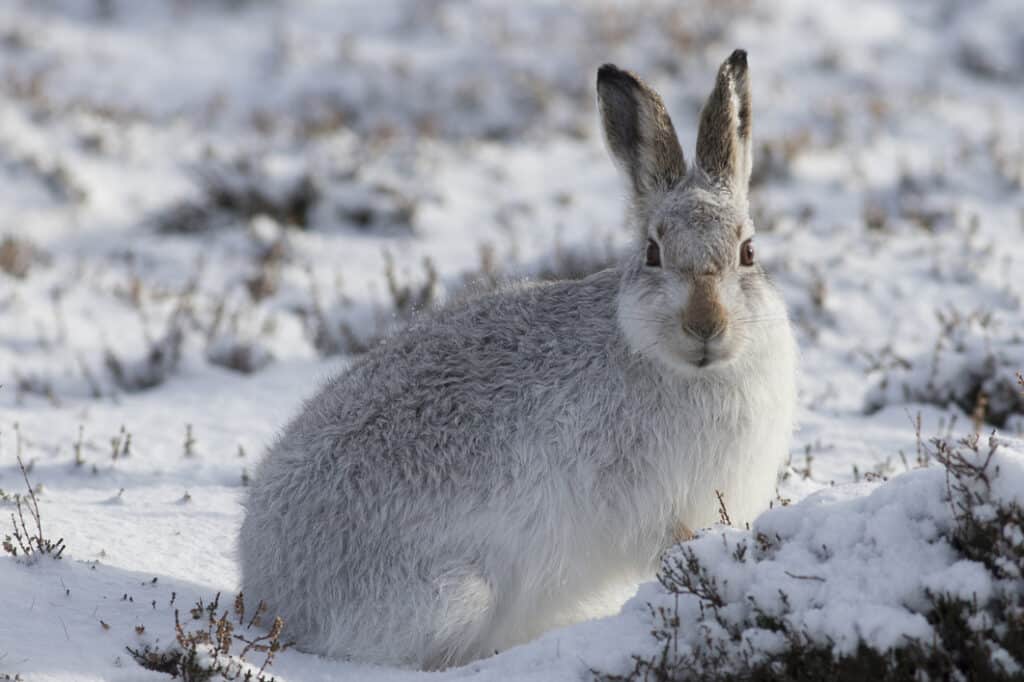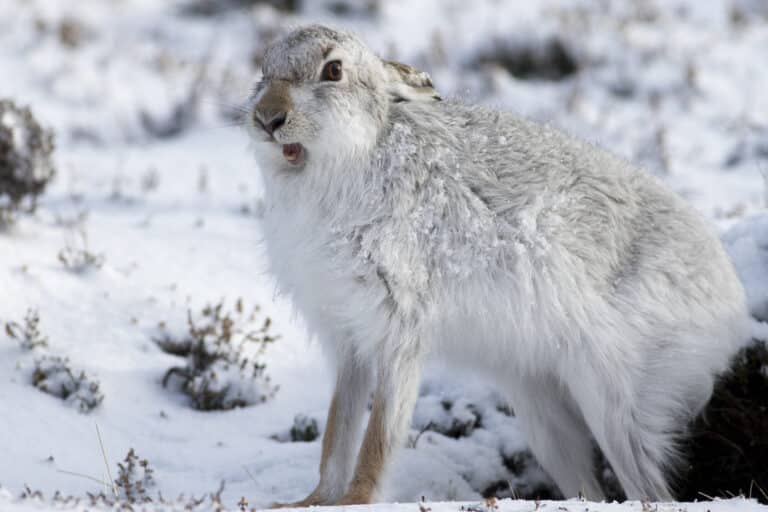Facts about the Mountain Hare
Scientific name: Lepus timidus
At a glance
- Our only native lagomorph (hares and rabbits) and strongly associated with heather moorland.
- Widely persecuted on grouse moors for carrying sheep ticks that can pass disease to Red Grouse.
- In 2020 the Scottish parliament voted to give Mountain Hares special protection.

Distributed from Fennoscandia to eastern Siberia with outlying populations in locations as geographically separated as Hokkaido and the Baltics, the Mountain Hares is indigenous to Britain (unlike the European Rabbit and the Brown Hare both of which were introduced here by the Romans several thousands of years ago).
Although elsewhere the species mainly occupies boreal forest, in Britain it is associated with heather moorlands. It is native to the Highlands of Scotland but has been introduced to the Southern Uplands, the Peak District and on some Scottish Islands including Hoy (Orkney), Mainland (Shetland), Mull and Skye. In Ireland there is a genetically very distinct, slighter smaller form, the Irish Hare Lepus timidus hibernicus, which prefers undisturbed grasslands at lower elevations (leverets hidden in fields are often killed during silage cutting).

Distributed from Fennoscandia to eastern Siberia with outlying populations in locations as geographically separated as Hokkaido and the Baltics, the Mountain Hares is indigenous to Britain (unlike the European Rabbit and the Brown Hare both of which were introduced here by the Romans several thousands of years ago).
Although elsewhere the species mainly occupies boreal forest, in Britain it is associated with heather moorlands. It is native to the Highlands of Scotland but has been introduced to the Southern Uplands, the Peak District and on some Scottish Islands including Hoy (Orkney), Mainland (Shetland), Mull and Skye. In Ireland there is a genetically very distinct, slighter smaller form, the Irish Hare Lepus timidus hibernicus, which prefers undisturbed grasslands at lower elevations (leverets hidden in fields are often killed during silage cutting).
Also known as Blue Hares (or colloquially in winter as White Hares or Snow Hares), Mountain Hares are mainly active at night, and though considered browsers of woody, moorland plants like heather and other dwarf shrubs and trees, during the summer months they prefer to eat grasses when they are available. During periods of snow cover hares gather on leeward hill slopes in large groups to shelter or feed where shallow snow allows them to get to the heather beneath.
Mountain Hares have historically been considered too small to have commercial value either as a meat source or for shooting, but huge numbers have recently been routinely killed on grouse moors. Trailers loaded with dead hares have made poor adverts for the conservation claims of gamekeepers, but the data on whether the hares are declining overall has been hotly disputed (with conservationists – referencing the 2018 Watson-Wilson report which found severe declines – on one side, and shooting lobbyists and landowners – referencing anecdotal sightings of hare abundance – on the other).

There is little doubt though that hares are killed because they’re suspected to carry sheep ticks which can pass the Louping Ill virus to Red Grouse, despite any evidence to prove hares reduce grouse numbers ahead of the annual ‘inglorious’ massacre (the flocks of sheep roaming the moors carry sheep ticks too, of course, but no-one’s going to suggest removing them…).
It’s also true to say that Mountain Hares are one of the main prey items of Golden Eagles, which are routinely persecuted on grouse moors for also preying on grouse. It’s suspected that part of the reasoning behind removing hares is that it will slow down or discourage the recovery of Golden Eagles and their spread into new territories, including moorland shooting estates – yet another form of ‘legal’ predator control, in other words.
In 2019 the Joint Nature Conservation Committee, an expert advisory committee to the UK government, told the EU that Mountain Hares were in “unfavourable inadequate conservation status”, partly due to a lack of data about their numbers. Much to the irritation of ‘countryside managers’, in summer 2020 the Scottish parliament voted to give Mountain Hares special protection under the Wildlife and Countryside Act making it an offence to intentionally or recklessly kill or injure a hare without a licence.
With typical hyperbole and misreading of the room, Alex Hogg, the chairman of the Scottish Gamekeepers Association, said at the time that “this is an important date in the demise of another iconic species, killed by political trade-offs and emotive campaigns”.
For the rest of us who actually care about our wildlife, it was a welcome step forward in releasing the disproportionate grip that the shooting industry has on wildlife regulations.
